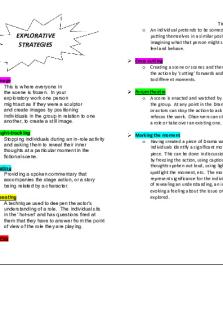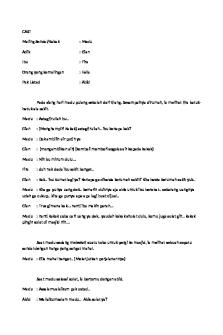Explorative Strategies in Drama PDF

| Title | Explorative Strategies in Drama |
|---|---|
| Author | Tierney Butcher |
| Course | Music Theatre Studies |
| Institution | Anglia Ruskin University |
| Pages | 2 |
| File Size | 153.6 KB |
| File Type | |
| Total Downloads | 34 |
| Total Views | 132 |
Summary
Techniques to support you in understanding the different concepts of drama within your lessons....
Description
EXPLORATIVE STRATEGIES
Still image o This is where everyone in the scene is frozen. In your exploratory work one person might act as if they were a sculptor and create images by positioning individuals in the group in relation to one another, to create a still image. Thought-tracking o Stopping individuals during an in-role activity and asking them to reveal their inner thoughts at a particular moment in the fictional scene. Narrating o Providing a spoken commentary that accompanies the stage action, or a story being related by a character. Hot-seating o A technique used to deepen the actor’s understanding of a role. The individual sits in the ‘hot-set’ and has questions fired at them that they have to answer from the point of view of the role they are playing. Role-Play
Tierney Butcher o An individual pretends to be someone else, by putting themselves in a similar position and imagining what that person might say, think, feel and behave. Cross-cutting o Creating a scene or scenes and then reordering the action by ‘cutting’ forwards and backwards to different moments. Forum theatre o A scene is enacted and watched by the rest of the group. At any point in the Drama, observers or actors can stop the action to ask for help or refocus the work. Observers can step in and add a role or take over an existing one. Marking the moment o Having created a piece of Drama work, individuals identify a significant moment in the piece. This can be done in discussion, marked by freezing the action, using captions, inner thoughts spoken out loud, using lighting to spotlight the moment, etc. The moment will represent significance for the individual in terms of revealing an understanding, an insight or evoking a feeling about the issue or idea being explored.
The Elements of Drama
Action/ Plot/ Content o The story, the characters, and/ or the theme(s) of the Drama. Forms o The way the story is told, how the characters are portrayed and/ or how the themes are depicted. Climax/ Anti-climax o Building and/ or releasing tension in the Drama and/ or a sense of expectation. Rhythm/ Pace/ Tempo o The rate at which the action moves along and the extent to which this changes. Contrasts o For example, stillness versus activity/ silence versus noise. Characterisation
Tierney Butcher o The means used to portray a role using vocal and physical skills. Conventions o Using techniques such as slow motion, freeze frame, audience asides, soliloquy, establishing one part of the space as one location and a different part of the space as another location. Symbols o The representational use of props, gestures, expressions, costume, lighting, and/ or setting. For example, blue lighting to represent night-time, a white costume to represent the innocence of a character.
The Drama Medium: The use of costume, masks and/ or makeup. The use of sound and/ or music. The use of lighting. The use of space and/ or levels. The use of set and/ or props. The use of movement, mime and/ or gesture. The use of voice. The use of spoken language....
Similar Free PDFs

Explorative Strategies in Drama
- 2 Pages

DRAMA
- 40 Pages

Drama adrama too long drama
- 1 Pages

Makalah drama
- 10 Pages

Introduction DRAMA
- 13 Pages

NASKAH DRAMA
- 11 Pages

Elizabethan Drama
- 5 Pages

Drama Pendidikan
- 5 Pages

Naskah drama
- 4 Pages
Popular Institutions
- Tinajero National High School - Annex
- Politeknik Caltex Riau
- Yokohama City University
- SGT University
- University of Al-Qadisiyah
- Divine Word College of Vigan
- Techniek College Rotterdam
- Universidade de Santiago
- Universiti Teknologi MARA Cawangan Johor Kampus Pasir Gudang
- Poltekkes Kemenkes Yogyakarta
- Baguio City National High School
- Colegio san marcos
- preparatoria uno
- Centro de Bachillerato Tecnológico Industrial y de Servicios No. 107
- Dalian Maritime University
- Quang Trung Secondary School
- Colegio Tecnológico en Informática
- Corporación Regional de Educación Superior
- Grupo CEDVA
- Dar Al Uloom University
- Centro de Estudios Preuniversitarios de la Universidad Nacional de Ingeniería
- 上智大学
- Aakash International School, Nuna Majara
- San Felipe Neri Catholic School
- Kang Chiao International School - New Taipei City
- Misamis Occidental National High School
- Institución Educativa Escuela Normal Juan Ladrilleros
- Kolehiyo ng Pantukan
- Batanes State College
- Instituto Continental
- Sekolah Menengah Kejuruan Kesehatan Kaltara (Tarakan)
- Colegio de La Inmaculada Concepcion - Cebu






